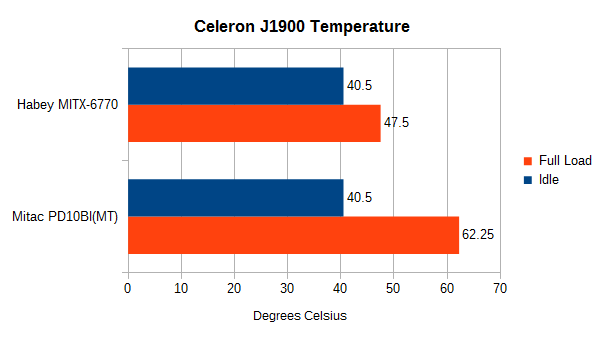
|
Columns | Projects | Reviews |
|
George Ross, August 6, 2015
These motherboards are based on Intel's Celeron J1900 processor. As the J1900 is not exactly a performance power house today's comparison will focus on features rather than performance. So without further ado here we go.

Neither of these motherboards boxes are meant for retail shelves and are designed to provide the essentials of keeping the motherboard from harm and housing the accessories. Both boxes are plain vanilla card board boxes. Mitac has added a little 'flash' with printed graphics. While Habey only has a sticker on the side with the manufacturer's name, model number, Product Code, UPC, MFG PN, HBSI, HBPO, and country of origin printed on it. Upon opening the boxes you will find Mitac's board sits on a nice tray with the accessories housed underneath. While Habey sits the accessories on a cardboard flap that covers the motherboard. Both motherboards come with anti static bagging, but Habey adds a little more protection buy adding bubble wrap on top of the anti static bag and a foam square on the underside of the board. This results in the Habey box being somewhat bigger than the Mitac box.



Just looking at the accessories alone could sway some people one way or the other.

These motherboards are very similar at first glance. They both have fan-less heat sinks, two DDR3L memory slots, a half height mini-PCIe slot, a full height mini-PCIe slot, a PCIe x1 slot, two SATA headers two RS-232 headers, and a LPT header. From here on it is differences galore.

Looking at the rear I/O area the differences are easy to see. While they both have VGA output, HDMI output, and audio output and input. The USB and LAN connectors is where they differ. The Habey board features two gigabit Ethernet connectors both utilizing Intel I210/I211 chips. While the Mitac board only has one gigabit Ethernet port sporting the Realtek RTL8111G-CG chip. However the Mitac board has two USB 2.0 and USB 3.0 connectors whereas the Habey board only has one USB 2.0 and USB 3.0 connector.
Digging in deeper the differences only get more stark. The Mitac board has variable DC input valtages (8V-19V) while the Habey board only supports 12V. The Mitac board has more on board video output options with the inclusion of LVDS and Embedded DisplayPort, but the Habey board does support LVDS via an add-on module.

Picture from Habey's website
Since I mentioned the add-on's. Habey's MITX-6770 supports proprietary add-on's. Habey has three add-on's available for the MITX-6770. They are the DDI 2nd HDMI add-on card, the DDI LVDS add-on card, and the POE+ 802.3at add-on module (Think more like a seperate POE power supply). These add-on's add extra functionality to the MITX-6770. Of course they also add extra cost too. Mitac's PD10BI(MT) does not have any proprietary add-on's however the POE+ 802.3at add-on module can be used to power the PD10BI(MT).
While it is quite apparent that these two motherboards are quite different. There is one feature the Habey board has that really sets it apart. That is it's SIM socket. This allows for cellular radio connectivity. One can easily see how this one feature could sway you into buying this board just for such connectivity.
| Processors | Intel Celeron J1900 | |
| Motherboards | Mitac PD10BI(MT) | Habey MITX-6770 |
| Memory | G. SKILL F3-1333C9D-8GSL 8GB DDR3L 1333 (PC3L 10666) 9-9-9-24 Dual Channel Mode | |
| SSD | Mushkin Enhanced Chronos MKNSSDCR120GB 2.5" 120GB SATA III MLC | |
| Video | Integrated graphics | |
| Power Supply | Rosewill RMNA-11001 Universal automatic Notebook Power Adapter 90W | Habey HB-POE1230 POE+ 802.3at |
| Operating System | Windows 8.1 Pro 32-bit | |
As mentioned earlier both of these motherboards feature a fan-less heat sink to cool their Celeron J1900's. I averaged the temperature readings from each core of the Celeron J1900 in order to get these figures. The full load temperatures were recorded after ten minutes of Prime 95 runs using the maximum temperature readings. The graph below shows how well they done in an open air environment.

The MITX-6770's larger heat sink does better job of cooling the Celeron J1900. Not that the PD10BI(MT) does a bad job. It is just not near as good as the bigger heat sink on the MITX-6770.
It is nice to know you have a couple of nice thin mini-ITX low power solutions available. I would prefer to see more options available in the low power thin mini-ITX market segment.


